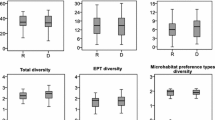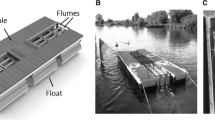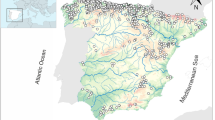Abstract
One of the key challenges of invasion biology in aquatic systems is determining the environmental conditions under which non-indigenous species establish populations in new habitats. It is widely believed that environmental degradation of streams and rivers may facilitate susceptibility to invasion; however, this has not yet been demonstrated consistently across a wide range of taxonomic groups. We analyzed macroinvertebrate data from 398 stream and river sites in Germany in order to test whether morphologically and physicochemically degraded stream and river habitats are more prone to invasion. Further, we identified the most important environmental variables facilitating invasion. The study confirmed that invaded sites were significantly more degraded than sites where only indigenous species were recorded. In both streams and rivers, invaded sites featured increased maximum temperatures, chloride and total organic carbon concentrations and a decreased morphological habitat quality. In streams, additionally the variables minimum temperature, oxygen, orthophosphate and ammonium contributed to greater degradation. In rivers also nitrate concentration was increased at invaded sites. Generalized linear models indicated that chloride was one of the most important variables that favored invasibility in both streams and rivers. In streams, the most indicative variables for invasion risk also included orthophosphate and maximum temperature. In rivers, in addition to chloride, morphological habitat quality was important. Our results confirm that the physicochemical and morphological intactness of riverine systems is a safeguard against invasion of aquatic non-indigenous macroinvertebrates. Based on this knowledge, management strategies can be developed to reduce invasion risk.



Similar content being viewed by others
References
Alonso A, Camargo JA (2003) Short-term toxicity of ammonia, nitrite, and nitrate to the aquatic snail Potamopyrgus antipodarum (Hydrobiidae, Mollusca). Bull Environ Contam Toxicol 70(5):1006–1012
Alonso A, Castro-Diez P (2008) What explains the invading success of the aquatic mud snail Potamopyrgus antipodarum (Hydrobiidae, Mollusca)? Hydrobiologia 614(1):107–116
Byers JE (2000a) Competition between two estuarine snails: Implications for invasions of exotic species. Ecology 81(5):1225–1239
Byers JE (2000b) Differential susceptibility to hypoxia aids estuarine invasion. Mar Ecol-Prog Ser 203:123–132
Camargo JA, Alonso A, Salamanca A (2005) Nitrate toxicity to aquatic animals: a review with new data for freshwater invertebrates. Chemosphere 58(9):1255–1267
DAISIE Delivering Alien Invasive Species Inventories for Europe (2010) European Invasive Alien Species Gateway. http://www.europe-aliens.org/. Accessed 1 Nov 2010
Davis MA, Grime JP, Thompson K (2000) Fluctuating resources in plant communities: a general theory of invasibility. J Ecol 88(3):528–534
Dextrase AJ, Mandrak NE (2006) Impacts of alien invasive species on freshwater fauna at risk in Canada. Biol Invasions 8(1):13–24
Didham RK, Tylianakis JM, Hutchison MA, Ewers RM, Gemmell NJ (2005) Are invasive species the drivers of ecological change? Trends Ecol Evol 20(9):470–474
Effler SW, Matthews DA, Brooks-Matthews CM, Perkins MG, Siegfried CA, Hassett JM (2004) Water quality impacts and indicators of metabolic activity of the zebra mussel invasion of the Seneca River. J Am Water Resour Assoc 40(3):737–754
Genovesi P, Shine C (2004) European strategy on invasive alien species: Convention on the Conservation of European Wildlife and Natural Habitats. Council of Europe Publishing, Strasbourg Cedex
Gollasch S, Nehring S (2006) National checklist for aquatic alien species in Germany. Aquat Invasions 1(4):245–269
Grabowski M, Bacela K, Konopacka A (2007) How to be an invasive gammarid (Amphipoda: Gammaroidea)—comparison of life history traits. Hydrobiologia 590:75–84
Grabowski M, Bacela K, Konopacka A, Jazdzewski K (2009) Salinity-related distribution of alien amphipods in rivers provides refugia for native species. Biol Invasions 11(9):2107–2117
Haase P, Lohse S, Pauls S, Schindehütte K, Sundermann A, Rolauffs P, Hering D (2004) Assessing streams in Germany with benthic invertebrates: development of a practical standardised protocol for macro invertebrate sampling and sorting. Limnologica 34(4):349–365
Haase P, Sundermann A, Schindehütte K (2006) Informationstext zur Operationellen Taxaliste als Mindestanforderung an die Bestimmung von Makrozoobenthosproben aus Fließgewässern zur Umsetzung der EU-Wasserrahmenrichtlinie in Deutschland—Stand März 2006. http://www.fliessgewaesserbewertung.de/downloads/Informationstext_zur_Operationellen_Taxaliste_Stand_17Mrz06.pdf. Accessed 10 Dec 2010
Havel JE, Lee CE, Vander Zanden MJ (2005) Do reservoirs facilitate invasions into landscapes? Bioscience 55(6):518–525
Hong ML, Chen LQ, Sun XJ, Gu SZ, Zhang L, Chen Y (2007) Metabolic and immune responses in Chinese mitten-handed crab (Eriocheir sinensis) juveniles exposed to elevated ambient ammonia. Comp Biochem Physiol C-Toxicol Pharmacol 145(3):363–369
IPCC Intergovernmental Panel on Climate Change (2007) Synthesis Report. Contribution of Working Groups I, II and III to the Fourth Assessment Report of the Intergovernmental Panel on Climate Change. http://www.ipcc.ch/publications_and_data/publications_ipcc_fourth_assessment_report_synthesis_report.htm. Accessed 17 Nov 2010
Johnson PTJ, Olden JD, vander Zanden MJ (2008) Dam invaders: impoundments facilitate biological invasions into freshwaters. Front Ecol Environ 6(7):359–365
Kamp U, Binder W, Hölzl K (2007) River habitat monitoring and assessment in Germany. Environ Monit Assess 127(1):209–226
Karatayev AY, Burlakova LE, Padilla DK, Mastitsky SE, Olenin S (2009) Invaders are not a random selection of species. Biol Invasions 11(9):2009–2019
Kestrup AM, Ricciardi A (2009) Environmental heterogeneity limits the local dominance of an invasive freshwater crustacean. Biol Invasions 11(9):2095–2105
LAWA Länderarbeitsgemeinschaft Wasser (1998) Beurteilung der Wasserbeschaffenheit von Fließgewässern in der Bundesrepublik Deutschland—Chemische Gewässergüteklassifikation-. Kulturbuchverlag, Berlin
LAWA Länderarbeitsgemeinschaft Wasser (2000) Gewässerstrukturgütekartierung in der Bundesrepublik Deutschland—Verfahren für kleine und mittelgroße Fließgewässer. Kulturbuchverlag, Berlin
Leuven R, van der Velde G, Baijens I, Snijders J, van der Zwart C, Lenders HJR, de Vaate AB (2009) The river Rhine: a global highway for dispersal of aquatic invasive species. Biol Invasions 11(9):1989–2008
Leyer I, Wesche K (2007) Multivariate Statistik in der Ökologie. Springer, Berlin
Lövei GL (1997) Biodiversity—global change through invasion. Nature 388(6643):627–628
MacDougall AS, Turkington R (2005) Are invasive species the drivers or passengers of change in degraded ecosystems? Ecology 86(1):42–55
MacNeil C, Dick JTA, Elwood RW (2000) Differential physico-chemical tolerances of amphipod species revealed by field transplantations. Oecologia 124(1):1–7
MacNeil C, Montgomery WI, Dick JTA, Elwood RW (2001) Factors influencing the distribution of native and introduced Gammarus spp. Irish river systems. Archiv Fur Hydrobiologie 151(3):353–368
MacNeil C, Dick JTA, Gell FR, Selman R, Lenartowicz P, Hynes HBN (2009) A long-term study (1949–2005) of experimental introductions to an island; freshwater amphipods (Crustacea) in the Isle of Man (British Isles). Divers Distrib 15(2):232–241
Pimentel D, Zuniga R, Morrison D (2005) Update on the environmental and economic costs associated with alien-invasive species in the United States. Ecol Econ 52(3):273–288
Piscart C, Dick JTA, McCrisken D, MacNeil C (2009) Environmental mediation of intraguild predation between the freshwater invader Gammarus pulex and the native G. duebeni celticus. Biol Invasions 11(9):2141–2145
Pöckl M (2009) Success of the invasive Ponto-Caspian amphipod Dikerogammarus villosus by life history traits and reproductive capacity. Biol Invasions 11(9):2021–2041
Prenter J, MacNeil C, Dick JTA, Riddell GE, Dunn AM (2004) Lethal and sublethal toxicity of ammonia to native, invasive, and parasitised freshwater amphipods. Water Res 38(12):2847–2850
Rahel FJ, Olden JD (2008) Assessing the effects of climate change on aquatic invasive species. Conserv Biol 22(3):521–533
Sax DF, Gaines SD (2003) Species diversity: from global decreases to local increases. Trends Ecol Evol 18(11):561–566
Schreiber ESG, Quinn GP, Lake PS (2003) Distribution of an alien aquatic snail in relation to flow variability, human activities and water quality. Freshw Biol 48(6):951–961
Schulz M, Bischoff M (2008) Variation in riverine phosphorus between 1994 and 2003 as affected by land-use and loading reductions in six medium-sized to large German rivers. Limnologica 38(2):126–138
Strayer DL (2010) Alien species in fresh waters: ecological effects, interactions with other stressors, and prospects for the future. Freshw Biol 55:152–174
van der Velde G, Leuven R, Platvoet D, Bacela K, Huijbregts MAJ, Hendriks HWM, Kruijt D (2009) Environmental and morphological factors influencing predatory behaviour by invasive non-indigenous gammaridean species. Biol Invasions 11(9):2043–2054
Vannote RL, Minshall GW, Cummins KW, Sedell JR, Cushing CE (1980) River continuum concept. Can J Fish Aquat Sci 37(1):130–137
Vermonden K, Leuven R, van der Velde G (2010) Environmental factors determining invasibility of urban waters for exotic macroinvertebrates. Divers Distrib 16(6):1009–1021
Vitousek PM, Dantonio CM, Loope LL, Rejmanek M, Westbrooks R (1997) Introduced species: a significant component of human-caused global change. N Z J Ecol 21(1):1–16
Weitere M, Vohmann A, Schulz N, Linn C, Dietrich D, Arndt H (2009) Linking environmental warming to the fitness of the invasive clam Corbicula fluminea. Global Change Biol 15(12):2838–2851
Werner S, Rothhaupt KO (2008) Mass mortality of the invasive bivalve Corbicula fluminea induced by a severe low-water event and associated low water temperatures. Hydrobiologia 613:143–150
Wijnhoven S, van Riel MC, van der Velde G (2003) Exotic and indigenous freshwater gammarid species: physiological tolerance to water temperature in relation to ionic content of the water. Aquat Ecol 37(2):151–158
Williams JW, Jackson ST (2007) Novel climates, no-analog communities, and ecological surprises. Front Ecol Environ 5(9):475–482
Zedler JB, Kercher S (2004) Causes and consequences of invasive plants in wetlands: Opportunities, opportunists, and outcomes. Crit Rev Plant Sci 23(5):431–452
Zukowski S, Walker KF (2009) Freshwater snails in competition: alien Physa acuta (Physidae) and native Glyptophysa gibbosa (Planorbidae) in the River Murray, South Australia. Mar Freshw Res 60(10):999–1005
Acknowledgments
We are grateful to the Umweltbundesamt and the Hessisches Landesamt für Umwelt und Geologie (HLUG) for kindly providing the species and physicochemical and morphological data. Further, we wish to thank Sami Domisch, Heike Kappes and two anonymous referees for constructive comments. The present study was funded by the research funding program “LOEWE—Landes-Offensive zur Entwicklung Wissenschaftlich-ökonomischer Exzellenz” of Hesse’s Ministry of Higher Education, Research, and the Arts.
Author information
Authors and Affiliations
Corresponding author
Rights and permissions
About this article
Cite this article
Früh, D., Stoll, S. & Haase, P. Physicochemical and morphological degradation of stream and river habitats increases invasion risk. Biol Invasions 14, 2243–2253 (2012). https://doi.org/10.1007/s10530-012-0226-9
Received:
Accepted:
Published:
Issue Date:
DOI: https://doi.org/10.1007/s10530-012-0226-9




